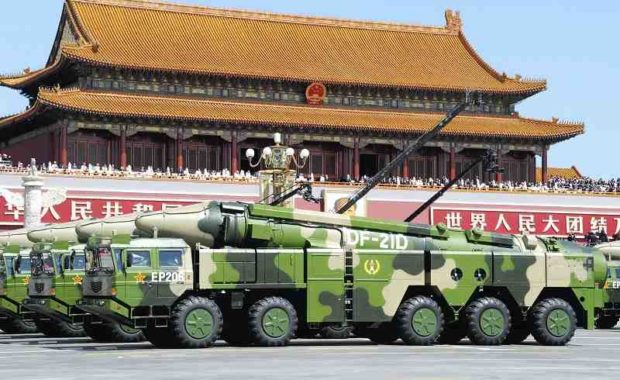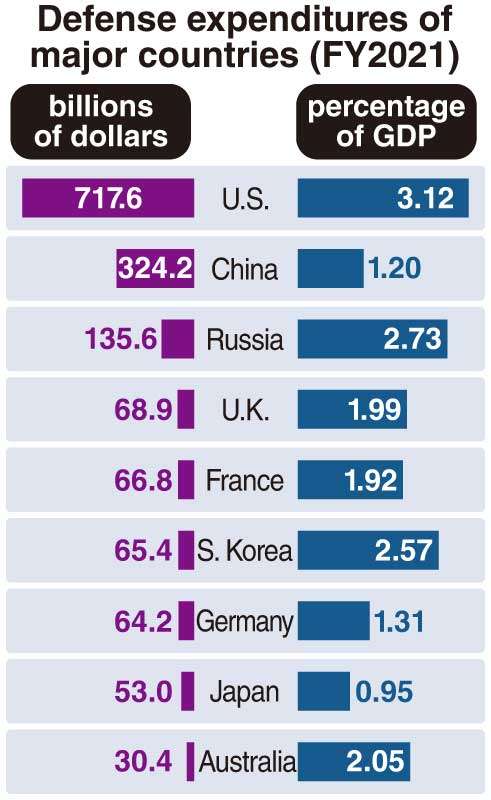Japan’s defense white paper includes hypothetical invasion of Taiwan by China

Yomiuri Shimbun file photo
The DF-21D (Dongfeng-21D) anti-ship ballistic missile, dubbed an “aircraft-carrier killer,” at Tiananmen Square in Beijing in September 2015
TOKYO — The Japanese government in its 2022 defense white paper released on Friday included a hypothetical invasion of Taiwan by China for the first time.
If an emergency were to occur in Taiwan, an island only about 110 kilometers away from Yonaguni Island, Okinawa Prefecture, the crisis would also inevitably affect Japan, which is why it is said, “An emergency for Taiwan is also an emergency for Japan.”
A senior Defense Ministry official said, “Taiwan is the region with the highest risk in the world, next to Ukraine. We need to have the Japanese people know what kind of situation would unfold,” explaining the reason why a hypothetical crisis in Taiwan has been included in the paper.
Enhancing operational capabilities
Concerning a possible timeline for a Chinese invasion of Taiwan, there are numerous hypotheses, including the year 2027 when China will mark the centennial of the founding of the People’s Liberation Army, and 2035, the year when China plans to achieve full modernization of its national defense system and armed forces.
On China’s mind is the movements of the U.S. forces. It aims to impede their operations within the Second Island Chain, which begins at the Izu Islands and extends down to Guam, an American territory, and to block them from entering the First Island Chain, which links the Nansei Islands and the Philippines.
China has already deployed the Dongfeng-21D, an anti-ship ballistic missile that, with its maximum range of about 1,500 kilometers, has been dubbed an “aircraft-carrier killer.”
With regard to frequent advances into the Pacific Ocean by vessels of the Chinese Navy, the white paper assesses that China “is aiming to enhance its operational capabilities in the open sea.”
In May, China repeatedly practiced takeoffs and landings on its Liaoning aircraft carrier in the Pacific waters near Okinawa, a drill believed to have been conducted in anticipation of an invasion of Taiwan.
Nonetheless, as the Chinese military is said to face problems such as in transport capabilities, the white paper also included the position taken by Taiwan’s Defense Ministry that China “is not fully equipped” with the capability to conduct any large-scale landing operation on Taiwan.
3-front response
The Japanese government has been on the alert for cooperation between China and Russia. The Chinese military possesses Xian H-6 bombers, capable of carrying anti-ground cruise missiles, and in May conducted a joint flight with bombers of the Russian forces, flying over the East China Sea through to the Pacific Ocean. Chinese and Russian naval vessels have also been known to sail together in the waters around Japan.
Some believe that in the event of an emergency in Taiwan, North Korea may also embark on simultaneous military actions. Japan could even be forced to respond on the three fronts of China, North Korea and the Russian Far East.
Katsutoshi Kawano, former chief of staff, Joint Staff, said, “Japan should strive to strengthen its defense capabilities by assuming that the three countries — Russia, China and North Korea, which all share the same values — would cooperate in taking military actions.”
Mulling counterattacks
The government will accelerate discussions aimed at revising three security-related documents, including the National Security Strategy, in light of its recognition, incorporated in the white paper, of the security environment surrounding Japan.

The Yomiuri Shimbun
Concerning the strengthening of defense capabilities, the government plans to push forward with discussions “without excluding any options, including counterattack capabilities,” as Prime Minister Fumio Kishida has put it.
The white paper also noted that North Korea has been moving ahead with developing ballistic missiles that fly on irregular trajectories at low altitudes, to enhance its capacity to make a saturation attack, where many missiles would be launched at once.
The white paper also refers to advanced hypersonic missiles, assessing that North Korea “is committed to developing such a system to break through a missile-defense system.”
Having said this, the paper then poses a question: “Can we truly defend people’s lives and livelihoods solely by enhancing our interceptive capabilities?” thus strongly suggesting the need for counterattack capabilities.
While bearing in mind criticism from some opposition parties that a counterattack would constitute a “preemptive attack,” the white paper emphasized that “the use of force by our country after an enemy has initiated an armed attack should not be confused with a ‘preemptive strike.’”
The white paper provides an international comparison of national defense outlays among the Group of Seven major economies. The defense outlays of the United States account for 3.12% of its gross domestic product, and those of South Korea represent 2.57% of its GDP. Meanwhile, those of Japan stand at less than 1%. The ruling Liberal Democratic Party is calling on the government to increase the defense budget, with a target of more than 2% of GDP in mind.
Yet, it is inevitable that the death of former Prime Minister Shinzo Abe, who was a key standard-bearer of the budget increase, should impact the discussion on defense outlays. During his talks at the Prime Minister’s Office on Friday with Ryu Shionoya, a former minister of education, culture, sports, science and technology and also a member of the Abe faction, Kishida said, “The loss of Mr. Abe is having a major impact,” expressing his uneasiness about the effect on the discussions aimed at revising the three defense-related documents.
As some have indicated that Komeito — the LDP’s coalition partner — and the Finance Ministry may more strongly assert their concerns over increasing defense outlays in the days ahead, the direction of the discussions will be sure to draw attention.
RELATED STORIES
Japan defense report sounds alarm on Russia, threats to Taiwan
Ukraine making China rethink when, not whether, to invade Taiwan – CIA chief
China will ‘not hesitate to start war’ over Taiwan, Beijing tells US
US says China’s pressure on Taiwan a threat to all democracies